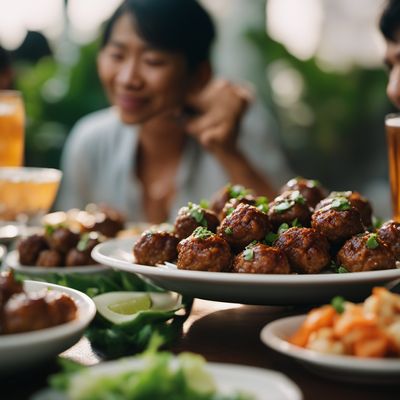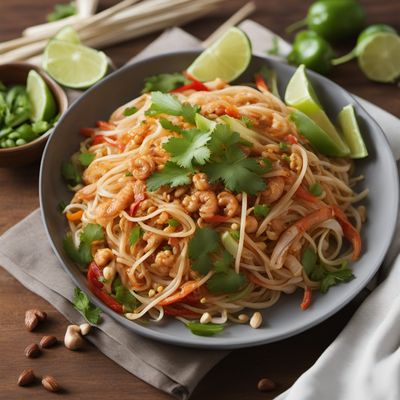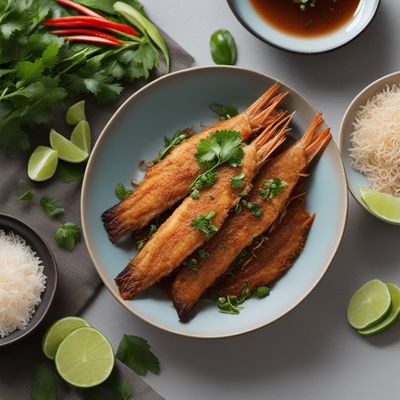
Recipe
Authentic Thai Shrimp Pad Thai
Tantalizing Thai Shrimp Delight
4.8 out of 5
Indulge in the flavors of Thailand with this authentic Thai Shrimp Pad Thai recipe. Bursting with vibrant ingredients and aromatic spices, this dish is a staple in Thai cuisine.
Metadata
Preparation time
20 minutes
Cooking time
10 minutes
Total time
30 minutes
Yields
4 servings
Preparation difficulty
Medium
Suitable for
Gluten-free, Dairy-free, Pescatarian, Low-fat, Nut-free
Allergens
Shellfish, Peanuts
Not suitable for
Vegan, Vegetarian, Paleo, Keto, High-protein
Ingredients
-
200g (7 oz) rice noodles 200g (7 oz) rice noodles
-
250g (9 oz) shrimp, peeled and deveined 250g (9 oz) shrimp, peeled and deveined
-
2 tablespoons vegetable oil 2 tablespoons vegetable oil
-
3 cloves garlic, minced 3 cloves garlic, minced
-
1 small onion, thinly sliced 1 small onion, thinly sliced
-
1 cup bean sprouts 1 cup bean sprouts
-
1/2 cup sliced bell peppers (assorted colors) 1/2 cup sliced bell peppers (assorted colors)
-
2 eggs, lightly beaten 2 eggs, lightly beaten
-
3 tablespoons tamarind paste 3 tablespoons tamarind paste
-
2 tablespoons fish sauce 2 tablespoons fish sauce
-
1 tablespoon soy sauce 1 tablespoon soy sauce
-
1 tablespoon palm sugar (or brown sugar) 1 tablespoon palm sugar (or brown sugar)
-
1/4 teaspoon chili flakes (adjust to taste) 1/4 teaspoon chili flakes (adjust to taste)
-
1/4 cup chopped fresh cilantro 1/4 cup chopped fresh cilantro
-
1/4 cup crushed peanuts 1/4 cup crushed peanuts
-
Lime wedges, for serving Lime wedges, for serving
Nutrition
- Calories (kcal / KJ): 380 kcal / 1590 KJ
- Fat (total, saturated): 10g, 2g
- Carbohydrates (total, sugars): 55g, 8g
- Protein: 20g
- Fiber: 4g
- Salt: 2g
Preparation
-
1.Soak the rice noodles in warm water for about 15 minutes until they are pliable. Drain and set aside.
-
2.In a wok or large skillet, heat the vegetable oil over medium-high heat. Add the minced garlic and sliced onion, and stir-fry for 1-2 minutes until fragrant.
-
3.Push the garlic and onion to one side of the wok and add the beaten eggs to the other side. Scramble the eggs until they are almost fully cooked.
-
4.Add the shrimp to the wok and stir-fry for 2-3 minutes until they turn pink and are cooked through. Remove the shrimp from the wok and set aside.
-
5.In the same wok, add the soaked rice noodles, bean sprouts, and sliced bell peppers. Stir-fry for 2-3 minutes until the noodles are tender and the vegetables are slightly softened.
-
6.In a small bowl, mix together the tamarind paste, fish sauce, soy sauce, palm sugar, and chili flakes. Pour the sauce over the noodles and vegetables in the wok.
-
7.Return the cooked shrimp to the wok and toss everything together until well combined and heated through.
-
8.Remove the wok from heat and garnish the Pad Thai with chopped cilantro and crushed peanuts.
-
9.Serve the Pad Thai hot with lime wedges on the side for squeezing over the dish.
Treat your ingredients with care...
- Rice noodles — Ensure that the noodles are soaked until they are pliable but not overly soft. Over-soaking can result in mushy noodles.
- Tamarind paste — Use a good quality tamarind paste for an authentic flavor. If the paste is too thick, you can dilute it with a little warm water before adding it to the dish.
- Fish sauce — Look for a high-quality fish sauce that is made from anchovies or other small fish. It adds a unique umami flavor to the Pad Thai.
Tips & Tricks
- To add extra flavor, marinate the shrimp in a mixture of fish sauce, lime juice, and garlic for 15 minutes before cooking.
- Customize the level of spiciness by adjusting the amount of chili flakes or adding fresh Thai chilies.
- For a vegetarian version, substitute the shrimp with tofu or a variety of colorful vegetables like broccoli, carrots, and snow peas.
- Garnish the Pad Thai with fresh bean sprouts, sliced green onions, and a sprinkle of dried shrimp for added texture and flavor.
- Leftover Pad Thai can be refrigerated and enjoyed the next day. Reheat it in a skillet with a little oil to maintain its texture.
Serving advice
Serve the Thai Shrimp Pad Thai hot, garnished with fresh cilantro, crushed peanuts, and lime wedges. Accompany it with a side of bean sprouts and sliced green onions for an extra crunch.
Presentation advice
Present the Pad Thai on a vibrant plate, allowing the colorful ingredients to shine. Garnish it with a lime wedge and sprinkle crushed peanuts and cilantro over the top for an appealing visual contrast.
More recipes...
For Thai cuisine » Browse all

Spicy Thai Red Curry with Chicken
Fiery Delight: Thai Red Curry Infused with Spices and Chicken

Khai Phalo - Thai-Style Braised Eggs in Spiced Coconut Sauce
Coconutty Delight: Thai-Style Braised Eggs in Fragrant Spiced Sauce

Thai Fish Cakes with Spicy Dipping Sauce
Fiery Thai Fish Cakes: A Burst of Flavor in Every Bite
More Thai cuisine dishes » Browse all

Roasted Lobster Tails with Coconut Curry Dipping Sauce
Roasted Lobster Tails with Coconut Curry Dipping Sauce is a luxurious and flavorful dish that is perfect for special occasions.

Nam prik gaeng karee
Nam prik gaeng karee is a traditional Thai curry paste that is used in a variety of dishes.

Luk chin ping
Thai grilled meatballs
Luk chin ping is a popular Thai street food that is made with grilled meatballs on skewers. The meatballs are marinated in a flavorful mixture of...


